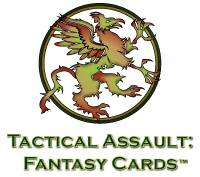Campaigns… Dungeon Delving II
Continuing on with our articles about running Dungeon Delving Campaigns with the Fantasy Cards, this time we will go into a little more detail about the Storyline Campaign.
Dungeon delving Storyline Campaigns are pretty much set up in the same campaign format mentioned in the basic rules, with two major differences. The first difference being that one force will not be allowed to change for the duration of the campaign (the Heroes), while the other may change with each battle (the heroes’ Antagonists). This means that unlike the standard campaign, the Heroes will not be able to spend campaign points between battles to change out units in their force – what they start with is what they finish with.
The second major difference comes in how the storyline impacts the final outcome of the campaign. When setting up these types of campaigns, specific scenarios should be designed that outline the heroes’ purpose in engaging in each battle, the significance of their winning or losing on the storyline and any special features of the battle (e.g. unique terrain, special rules, etc.). As part of the impact on the storyline, there should also be an effect on each side’s final campaign points – either as bonuses or penalties assessed at the end of the campaign. As each battle is resolved, the results are recorded, the storyline adjusted and then the next battle is fought.
Here are some examples of how scenarios might be set up:
Battle #1: Temple of Might
Story: The Heroes must defeat the guardians in the temple room to recover the magical artifact of a lost kingdom; if they fail, they are chased from the room without it. Specials: None.
Battle #2: Chasm Bridge
Story: The Heroes must defeat the evil monsters that claim the bridge as their own, or they cannot cross it and will be forced to skip Scenario #3: The Healing Fountain. Specials: Units that Fallback into the Chasm count as Eliminated (though they are rescued and returned after the fight).
Battle #3: Healing Fountain
Story: The Heroes must defeat the guardians of the Healing Fountain so they can acquire a sample for analysis; if they fail, they are chased from the room without it. Specials: Slippery Floors (all movement is halved).
And so on…
After playing out all of the battles of the campaign, you take note any special bonuses for the story points of the campaign and add those in. In our example, these would be things like:
> Recovered Magical Artifact in Scenario #1 (Heroes +2 Campaign Points)
> Skipped Scenario #3 (Antagonists +3 Campaign Points)
> Acquired Fountain Sample in Scenario #3 (Heroes +1 Campaign Point)
Then all of the campaign points are added up and converted into Promotion Awards per the normal campaign rules. These will decide the winner of the campaign. If the Heroes have the most Promotion Awards at the end, they have cemented their legendary status with tales of their heroic deeds! If the Antagonist’s forces have more Promotion Awards, then the dungeon got the better of the heroes and has raised its reputation as a Heroes’ Bane.
In a nutshell, there are the basics on running a Storyline Campaign. With a little imagination, you can see the possibilities are quite endless. Next time, we’ll look at the alternative to the Storyline Campaign – the dungeon delving Endurance Campaign…





